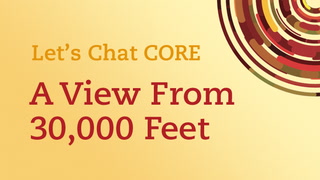[00:00]
Interviewer: Hello, and welcome to Let’s Chat Core. I’m Sarah Brown Wessling. Today’s topic is getting beyond right answers, seeing math classrooms in the Common Core State Standards. Our learning purpose today is to learn how teachers and students are shifting their math classrooms to promote mathematical reasoning. This is crucial because so much of what teachers are trying to grasp boils down to how the math classroom looks and functions similarly and differently than before. Of course, there have always been math classrooms with an attention to promoting mathematical reasoning or creating mathematicians, but the Core works to leverage such classrooms for all students across the country to help them become prepared to competently choose a career or college after high school.
I’ve said this many times before, but it does bear mentioning again as we begin talking about math classrooms in light of the Core. Common isn’t the same. The standards are not curriculum. In other words, just because we have a set of common standards it doesn’t mean that all classrooms will look the same. In fact, they shouldn’t. While we aim to teach to the standards, the way in which we get there and the curriculums we use to get there should be relevant and appropriate to your students in your school.
As a refresher, let’s take a quick look at how to read the math standards. First, you’ll notice the large groups of related standards, the domain. Then you’ll notice the standard itself in more specificity. Finally, the clusters give a degree of detail that teachers may not be accustomed to from using previous standards. Implicit in this detail, though, is a precision that gives teachers a more focused sense of what to teach thereby allowing them to ultimately let go of more content. I know, it’s counter intuitive, more specificity equals more freedom? But actually, it does. Although we’ll talk more about this soon, it is important to realize that the freedom lies in going deeper, not in covering more content.
While the domains, standards and clusters must change to account for the ages of learners and the types of math courses students take in secondary schools, one strand stays the same throughout: the mathematical practices. Truly it is one of my favorite components of any aspect of the Common Core, either math or English Language Arts. It’s because it focuses an attention on the dispositions that help students take charge of their own learning over the course of their school experience and beyond, whether it’s reasoning, constructing arguments or attending to precision. I know that when I can say to my own child working on his homework at the kitchen table, “Wow, you really fought through your frustration and kept working to find an answer that makes sense,” I’m supporting his learning and the Common Core State Standards too.
In my experience with learning about the Common Core State Standards, I’ve had a few aha moments when it comes to the math component. I recently heard David Coleman speak at the ECS National Forum on Education Policy, and there he talked about the need to focus on fewer concepts. He said that, “We need coherence so that we’re teaching for mastery instead of re-teaching year after year, and finally we need to approach these concepts with more rigor.” Let’s take a little bit of time here and look at what focus, coherence and rigor actually means in the classroom.
First of all, focus means fewer things at any given time. It’s really about mastery instead of coverage; it’s about depth instead of breadth. The focus is really crucial because without this kind of attention to conceptual understanding, we’re more likely to rely on getting through a lot of material, which lends itself to rote memorization and right answers versus the deep procedural knowledge.
The writers of the Common Core have also relied on the coherence of learning progressions in the writing of the math standards. In other words, instead of kind of this lily pad approach to teaching math, which means that students would hop from content to content or skill to skill from course to course or grade to grade without cohesive progressions, now those progressions are designed to build on each other in very systematic ways as the Core has been written. There’s research to back up the need for these progressions.
The 2007 TIMSS study looked at math sequences internationally and found that in most of the high achieving countries students would focus on fewer skills with greater depth before moving on
[05:00] from one year to year or course to course. However, the study also uncovered that in the United States students might learn the same topic or same skill over and over and over again, not necessarily having mastered it at any given time. That might mean students could learn about whole numbers in first grade and third grade and in fifth grade without ever having mastered it to the point that they really need to in order to transfer that learning or in order to build on it.
The coherence piece essentially says let’s help our students understand, in this case, the concept of whole numbers so that they can be more effectively built on later, and of course, all roads lead to algebra. It’s that place where the ability to think abstractly and to reason become the crucial underpinnings of so much other math and science.
Now for rigor. Well, the word rigor might suggest to some that you do more or you do it faster. I really like to think of rigor as being able to transfer your knowledge from one learning scenario or experience to the next. It means having both the procedural fluency and a conceptual understanding. Procedurally, students must have confidence and a certain degree of speed with calculations, but we certainly don’t want them to be practicing mindless rote procedures either. After all, we commit to habit what we practice, and if our students come to believe that math is reduced to flashcards and timed fact quizzes, then we’re shortchanging the way in which they can see patterns and concepts within the discipline of math.
Finally, the road to algebra is traversed through fractions. We know that a student’s ability to understand fractions has a significant impact on how she will approach algebra later, so this is an example of why it’s so crucial for students to not just have a superficial sense of a mathematical concept and procedure, but to really understand it fully so as to transfer that knowledge to learning algebra.
Even when all of this makes senses, there are still some natural questions that bubble to the surface. For example, what does this mean for teachers? Well, it means that there are shifts. EngageNY has actually identified six of these shifts that I think can be really instructive and helpful for us. The first is focus, and then coherence, fluency, a deep understanding, application and a dual intensity. When we understand what these shifts mean and we as teachers have a deep conceptual understanding of these shifts, we’re able to gain confidence in how we implement the Core into our classrooms.
Teachers will undoubtedly ask, “Where do we find the time?” An interview with Kate O’Donnell from America Achieves revealed to me that teachers will find the time by figuring out what to let go of and to focus on the work of the grade, as she says. If you’re anything like me, you are a teacher who always wants to do the right thing. As teachers, I think we often pile things on because we’re too afraid to stop teaching something out of fear that we won’t be fulfilling our responsibilities, but here’s the secret to implementing the Core that you’ll hear the writers often mention. The way to find the time to go deeper is by letting go of what isn’t the focused work of the grade.
That means we’re going to do three things. We’re going to determine our focus. We have to give ourselves permission to let go of the unessential, and we have to commit to depth over breadth. Implementing the Standards also means not just doing the math, but using the math. It’s the moment where Sooni 08:43 Park poses a problem of area, or when Madeline Noonan challenges her students with the math problem of the month. It’s when I’m doing homework with my own children, and we’re walking around the house applying the math and not just completing or finishing it.
Walking into a math class today should look engaged. Students should be doing the math. It should be loud. Students are talking to each other about their predictions and their reasoning while solving problems. It should be collaborative. Teachers and students, students and teachers are all working to teach each other the many ways of solving problems, and it should be thoughtful. Students will take time to reflect on their processes as they gain confidence through discourse and practice.
To recap this session, we’ve learned that focus, coherence and rigor are three of the tenets of the Common Core State Standards in math. We’ve learned that the shifts create more space for depth, and we’ve learned that classrooms are creative, engaged and even noisy when they are implementing the Common Core State Math Standards.
[10:00] Thank you for joining me on Let’s Chat Core. Be sure to look at our other Webinars as resources on the Common Core at teachingchannel.org. Have an inspired teaching day!
[End of Audio]














32 Comments
Miok Chung May 5, 2021 1:34pm
.
Melinda Roche May 3, 2020 7:50pm
I agree with Karen.
Karen McElhenny Dec 29, 2016 10:16am
janet mckinney Jan 26, 2016 5:53pm
Jennifer Letourneau Jan 24, 2016 5:51pm